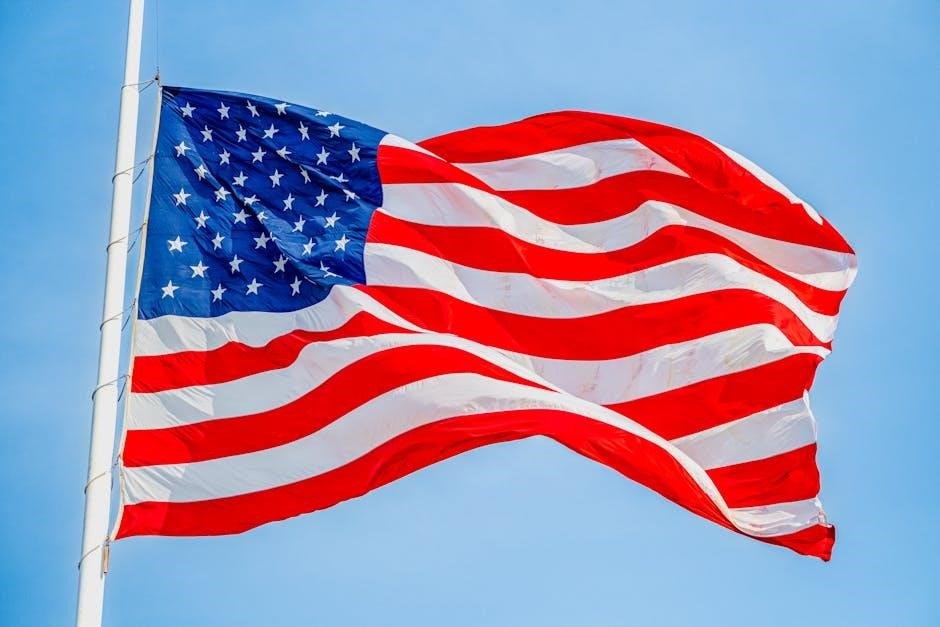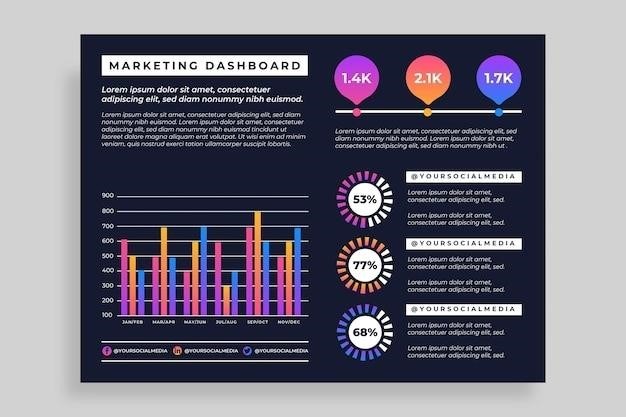Historical Background of The Star Spangled Banner
The Star Spangled Banner originated during the War of 1812, inspired by Francis Scott Key’s poem after witnessing the Battle of Baltimore. The melody, from a British song, was paired with Key’s lyrics, celebrating the American flag’s resilience. Initially a poem, it gained popularity and was officially adopted as the U.S. national anthem in 1931, symbolizing patriotism and freedom.

1.1 Composition and Inspiration

The Star Spangled Banner was composed by John Stafford Smith, with lyrics by Francis Scott Key. Inspired by the Battle of Baltimore in 1814, Key wrote the poem after witnessing the American flag still waving above Fort McHenry. The melody, derived from the popular British song “To Anacreon in Heaven,” was paired with Key’s patriotic verse, creating a powerful symbol of resilience. The song’s composition reflects the spirit of American determination during the War of 1812. Its inspiration stems from the bravery displayed during the battle, making it a timeless representation of national pride and freedom. The combination of melody and lyrics has endured as a celebration of American heritage.
1.2 The Battle of Baltimore and its Significance
The Battle of Baltimore, fought in September 1814, was a pivotal event in the War of 1812. British forces launched a naval and land attack on Baltimore, aiming to capture the city. The defense of Fort McHenry, led by Colonel George Armistead, repelled the British fleet, inspiring Francis Scott Key to write the poem that became “The Star Spangled Banner.” This battle marked a turning point, boosting American morale and demonstrating the nation’s resilience against foreign threats. The successful defense of Baltimore symbolized American determination and laid the groundwork for the Treaty of Ghent, ending the war. The bravery displayed during this battle remains a cornerstone of American patriotic history.
1.3 Adoption as the National Anthem
The Star Spangled Banner was officially adopted as the U.S. national anthem on March 3, 1931, through a congressional resolution. This decision followed decades of its popularity at public events and military ceremonies. Initially, the song gained prominence after the Battle of Baltimore in 1814 but lacked official status. Its patriotic significance and widespread use led to its formal recognition. The adoption involved standardizing the melody and lyrics, ensuring uniformity across performances. This milestone cemented the anthem’s role in American culture, symbolizing national pride and unity. The official designation has since been celebrated, with its performance at various national events reinforcing its importance in American identity.

Sheet Music and Arrangements
The Star Spangled Banner is available as free PDF sheet music for piano, guitar, flute, and other instruments in multiple keys, with vocal harmonies and singer resources.
2.1 Various Instrumental Arrangements
The Star Spangled Banner is available in multiple instrumental arrangements, including piano, guitar, flute, and other treble and bass clef instruments. These arrangements cater to diverse skill levels, from easy to intermediate, ensuring accessibility for musicians of all backgrounds. Additionally, the anthem has been adapted into various formats such as solo piano, two-part harmonies, and full orchestral scores. Many websites offer free PDF downloads of these arrangements, making it easy for individuals to practice and perform. The versatility of these instrumental versions allows the anthem to resonate across different musical genres and settings, maintaining its patriotic essence while appealing to a wide audience.

2.2 Vocal Arrangements and Harmonies
The Star Spangled Banner offers rich vocal arrangements, including SATB (Soprano, Alto, Tenor, Bass) harmonies and a cappella versions. These arrangements provide a lush, patriotic sound, suitable for choirs and vocal ensembles. The anthem is also available in multiple keys to accommodate different vocal ranges, ensuring accessibility for singers of all levels. Additionally, resources like “find-your-pitch” exercises are provided to help vocalists tune into the correct pitch. Many websites offer free PDF downloads of vocal scores, including lyrics and harmonies, making it easy for educators and performers to use them for practice or public performances. These arrangements highlight the song’s emotional depth and national significance.
2.4 Availability in Multiple Keys
The Star Spangled Banner is available in multiple keys, catering to various instrumental and vocal ranges. This versatility ensures that musicians of all skill levels can perform the anthem. From treble clef instruments like flute and violin to bass clef instruments like cello and trombone, sheet music is accessible in different keys. Additionally, arrangements for guitar, ukulele, and piano are offered in various keys to suit individual preferences. This adaptability makes the anthem widely accessible, allowing for diverse interpretations while maintaining its patriotic essence. The availability of multiple keys ensures that the song remains a unifying piece across different musical ensembles and performances. This inclusivity highlights its enduring cultural significance.
2.5 Singers’ Exercises and Resources
Singers can benefit from various exercises and resources to master The Star Spangled Banner. A “find-your-pitch” exercise is available, helping vocalists identify their starting note. Sheet music includes all four verses, allowing for comprehensive practice. Multiple keys are provided, catering to different vocal ranges, from soprano to bass. Free PDF downloads offer lyrics, melody, and accompaniment. These resources enable singers to refine their technique and deliver a powerful performance. Additionally, educational materials provide insights into the anthem’s history and significance. These tools support vocalists of all levels, ensuring they can perform the anthem with confidence and precision, fostering a deeper connection to its patriotic message.
Lyrics and Verses
The Star Spangled Banner features four original verses written by Francis Scott Key, describing the American flag’s resilience during the Battle of Baltimore. The lyrics reflect patriotism and freedom, with additional verses added over time. The song’s verses have been interpreted and parodied, expanding its cultural impact.

3.1 The Four Original Verses
The Star Spangled Banner’s original four verses, written by Francis Scott Key, vividly depict the Battle of Baltimore and the flag’s resilience. The first verse, the most commonly sung, describes the flag waving above Fort McHenry, symbolizing American defiance. The second verse reflects on the battle’s ferocity and the nation’s triumph. The third verse honors the bravery of American soldiers, while the fourth serves as a celebration of victory and unity. These verses capture the spirit of patriotism and freedom, embodying the anthem’s enduring significance. The lyrics have been widely praised for their poetic depth and historical context.
3.2 Historical Context of the Lyrics
The lyrics of The Star Spangled Banner were penned by Francis Scott Key during the War of 1812, inspired by the bombardment of Fort McHenry by the British Navy. The poem reflects the emotional turmoil and patriotism of the era, as Key witnessed the American flag still waving after the battle, symbolizing resilience and freedom. The flag’s endurance through “rocket’s red glare” and “bombs bursting in air” became a powerful symbol of American determination. Written as a poem, the lyrics later paired with John Stafford Smith’s melody, creating the anthem. The historical context underscores themes of patriotism, unity, and the struggle for independence, making the song a timeless representation of American spirit.
The Star Spangled Banner’s lyrics, written by Francis Scott Key, are rich in imagery and symbolism, evoking patriotism and resilience. Key’s vivid descriptions of the battle, such as “rocket’s red glare” and “bombs bursting in air,” create a visual narrative of the chaos and intensity of war. The anthem’s central theme revolves around the enduring American flag, symbolizing freedom and perseverance. The phrase “land of the free and home of the brave” encapsulates the nation’s values. Musically, the melody’s range and complexity reflect the dramatic nature of the lyrics, making it a challenging yet powerful piece to perform. This combination of poetic imagery and musical grandeur has cemented the anthem’s status as a national symbol, resonating deeply with Americans for generations. Beyond the four original verses, The Star Spangled Banner has inspired numerous additional and parody versions. A fifth verse, added during the Civil War, reflects the era’s tensions but remains lesser-known today. Parody versions, often humorous or satirical, have been created for various purposes, from political commentary to educational tools. These adaptations highlight the anthem’s versatility and cultural significance. Despite their creative deviations, they often retain the original melody, connecting them to the anthem’s historical roots. This evolution demonstrates how the song has been reinterpreted to resonate with different audiences and contexts, maintaining its relevance across generations. Such variations showcase the enduring influence of The Star Spangled Banner in American culture. The Star Spangled Banner has been performed by renowned artists and in various instrumental versions. It’s a staple at sports events and national celebrations, symbolizing American pride and unity. The Star Spangled Banner has been memorably performed by iconic artists, enhancing its cultural impact. Lady Gaga’s rendition at President Biden’s inauguration was widely praised for its emotional depth. Other notable performances include Whitney Houston’s powerful delivery at the 1991 Super Bowl, which became a benchmark for national anthem renditions. Additionally, instrumental versions by celebrated musicians like Sergei Rachmaninoff and Vladimir Horowitz have showcased the anthem’s versatility. These performances not only highlight the anthem’s significance but also demonstrate its ability to transcend traditional arrangements, appealing to diverse audiences and solidifying its place in American cultural heritage. Such renditions continue to inspire and unite people across generations. The Star Spangled Banner is a staple at American sporting events, most notably before baseball games and the Super Bowl. Its performance has become a cherished tradition, often featuring renowned artists. Whitney Houston’s iconic rendition at Super Bowl XXV in 1991 remains a benchmark for national anthem performances. Similarly, Lady Gaga’s powerful delivery at the 2016 Super Bowl highlighted the anthem’s enduring relevance. Beyond sports, the anthem is played at patriotic events, parades, and state ceremonies, evoking national pride and unity. These performances not only honor the song’s historical significance but also adapt it to modern cultural contexts, ensuring its continued resonance with diverse audiences. The Star Spangled Banner has been reimagined through countless instrumental arrangements, each offering a unique interpretation. Notable versions include Jimi Hendrix’s legendary guitar solo at Woodstock, blending patriotism with psychedelic rock. Ray Charles’s soulful piano rendition brought a heartfelt, emotive twist. Classical arrangements by Sergei Rachmaninoff and orchestral performances by major symphonies have also elevated the anthem. Instrumental versions allow for creative expression while preserving the song’s essence. These renditions are widely available in sheet music formats, enabling musicians to explore diverse styles. Whether performed by a solo artist or a full ensemble, instrumental versions of The Star Spangled Banner continue to inspire and celebrate American heritage. The Star Spangled Banner embodies American patriotism, unity, and resilience. It is widely used in education to promote national pride and historical awareness, reflecting the nation’s identity. The Star Spangled Banner is a cornerstone of American patriotism, symbolizing national pride and resilience. Adopted in 1931, it reflects the nation’s history and unity. The anthem is played at sports events, ceremonies, and public gatherings, fostering a sense of shared identity. Its lyrics, inspired by the Battle of Baltimore, evoke the bravery and spirit of American defenders. The song’s presence in education and cultural events promotes patriotism and historical awareness. It unites citizens across generations, transcending political divides. The anthem’s enduring relevance underscores its role as a cultural and patriotic symbol, celebrated by Americans nationwide. Its melody and lyrics continue to inspire pride and loyalty to the nation. The Star Spangled Banner is widely used in educational settings to teach patriotism, history, and cultural heritage. Schools often incorporate the anthem into music classes, with free PDF sheet music available for students and educators. The anthem’s historical context, including its origins during the War of 1812, is taught in history lessons. Educational resources, such as downloadable scores and lyrics, help students learn and perform the anthem. Many schools feature the anthem in assemblies, sports events, and patriotic ceremonies, fostering a sense of national pride. Additionally, the anthem is used to educate about Francis Scott Key’s role and the significance of the American flag. This educational promotion ensures the anthem’s legacy endures through generations. The Star Spangled Banner is in the public domain, meaning its use is not restricted by copyright. This allows free distribution of sheet music and performances without legal barriers. PDF versions of the anthem are widely available, with no copyright infringement concerns. However, specific arrangements or recordings may hold copyrights, requiring permission for commercial use. Educational and non-commercial uses generally remain unrestricted. The anthem’s status as a national symbol ensures its accessibility, promoting its widespread use in various contexts. Legal protections primarily focus on respecting the anthem’s dignity during performances, rather than copyright issues. This public domain status facilitates its promotion and educational use across the United States. The Star Spangled Banner PDF is widely available for free download from sites like Musicaneo and SheetMusicFox, offering sheet music in multiple keys for educational use. To download the PDF of The Star Spangled Banner, you can visit websites like Musicaneo and SheetMusicFox, which provide free sheet music for educational purposes. These platforms offer arrangements for various instruments, including piano, guitar, and flute, in multiple keys. Additionally, resources like SheetMusicPlus and PDFMinstrel offer downloadable scores, ensuring accessibility for musicians of all levels. Many of these sites also include lyrics and historical context, making them invaluable for educational use. With a wide range of versions available, you can easily find the perfect arrangement to suit your needs. When downloading The Star Spangled Banner PDF, ensure you select the correct key for your instrument to maintain compatibility. Use a reliable PDF reader for clear visibility of musical notation and lyrics. Print on standard 8.5×11-inch paper for optimal formatting. Choose high-resolution files to avoid blurry text or music notes. Consider printing a test page to verify alignment and clarity before final output. For vocal scores, ensure proper spacing between verses for readability. Always check the file’s metadata for copyright permissions and usage rights. Printing in portrait orientation is recommended for sheet music. If printing multiple copies, use double-sided printing to conserve paper. Lastly, verify your printer settings to ensure accurate reproduction of the document. The Star Spangled Banner is in the public domain, meaning its usage is unrestricted for personal, educational, or non-commercial purposes. However, specific arrangements or adaptations may be copyrighted, requiring permission from the creator. For public performances or commercial use, ensure you have the necessary rights. Always credit the original arranger or publisher when reproducing or distributing the sheet music. Educational institutions can freely use the PDF for teaching purposes without seeking additional permissions. Verify the copyright details in the metadata of your downloaded file to comply with legal requirements. Respect intellectual property rights, especially for derivative works, to avoid infringement issues.3.3 Analysis and Interpretation
3.4 Additional and Parody Verses

Performances and Renditions
4.1 Famous Performances and Artists
4.2 Use in Sports and Events
4.3 Notable Instrumental Versions

Cultural Significance

5.1 Role in American Patriotism
5.2 Educational Use and Promotion
5.3 Legal and Copyright Aspects

Downloading the PDF
6.1 Free Resources and Websites
6.2 Tips for Downloading and Printing
6.3 Usage Rights and Permissions

